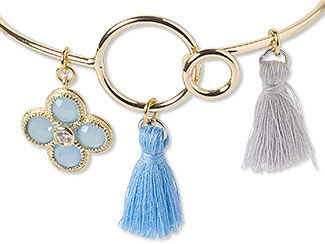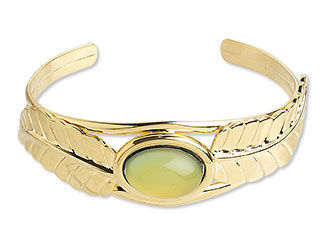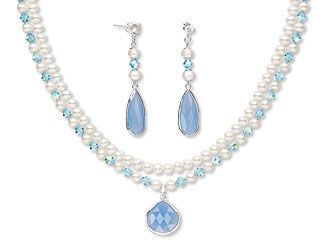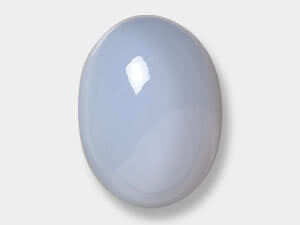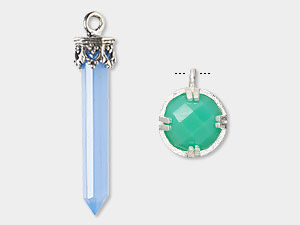Chalcedony Meaning and Properties
Chalcedony History
The first recorded discovery of chalcedony was reported in Istanbul Province, Turkey. It is theorized the name chalcedony comes from the name of the ancient town Chalcedony in Asia Minor. Today, deposits are found all over the world—including in Brazil, India, Madagascar, Malawi, Namibia, Zimbabwe, Sri Lanka, Uruguay and California. In its antiquity, chalcedony was commonly used as a wearable accessory with cameo carvings of water and air gods and goddesses. It was also used in the Middle East during the 1st and 2nd century to create seals, knives and other jewelry. Chalcedony still is commonly used in accessories such as rings and necklaces.
Watch this video and discover the beauty of chalcedony by crafting a DIY charm bracelet featuring this stone and complementary elements—ideal for gifting or selling.

What are the Metaphysical Properties of Chalcedony?
This gemstone is thought by many to be lucky for Cancer signs and a protective stone for Sagittarius. Many people believe in the healing and cleansing properties of the stone, and chalcedony meaning is associated with the absorption and dissipation of negative energy so that it does not transfer to other people. This is likely why chalcedony is also thought to align the body, mind and spirit.
In chakra practices, chalcedony is believed to be the stone of communication and is often placed by the pharynx to stimulate the throat chakra. The throat chakra is considered the voice of the body and allows energy or pressure from the other chakras to be released. If the throat chakra is blocked it is believed to cause problems with other chakras. Specifically, blue chalcedony is favored for this practice.
What is Chalcedony Made From?
Chalcedony is a species that is a mix of silica cryptocrystalline and a small percentage of moganite. Moganite has the same chemical composition as quartz but differs in the way its crystals form. Chalcedony is also typically a generalized name to encompass all cryptocrystalline forms of quartz. Cryptocrystalline structures have very fine crystalline structures that are invisible to the naked eye. While composed of fine layers, the layers are densely compacted, resulting in a stone more durable than other forms of quartz. These cryptocrystalline forms of quartz come in a wide variety of patterns, colors and sizes. Some examples of chalcedony varieties include:
- Aventurine
- Black Onyx
- Bloodstone (Heliotrope)
- Blue Chalcedony
- Carnelian (Red Chalcedony)
- Chrysoprase
- Green Chalcedony
- Green Onyx
- Petrified Wood
- Pink Chalcedony
- Sardonyx
- Tigereye
- White Chalcedony
- Yellow Chalcedony
- Blue Lace Agate
- Botswana Agate
- Crazy Lace Agate
- Dendritic Agate
- Fire Crackle Agate
- Fossil Agate
- Laguna Agate
- Landscape Agate
- Moss Agate
- Tree Agate
- Turritella Agate
- Wooden Agate
- Autumn Jasper
- Brecciated Jasper
- Dalmatian Jasper
- Dragon Blood Jasper
- Fancy Jasper
- Leopardskin Jasper
- Moukaite Jasper
- Ocean Jasper
- Picasso Jasper
- Picture Jasper
- Rainbow Brecciated Jasper
- Red Creek Jasper
- Red Flake Jasper
- Red Jasper
- Sesame Jasper
- Venus Jasper
However, unlike most quartz varieties, chalcedony in its natural state appears waxy or dull. While most quartz typically presents itself in trigonal forms, chalcedony occurs in various nodular and botryoidal patterns.
- Mineral Information: Microcrystalline, cryptocrystalline quartz and/or moganite
- Chemical Composition: SiO2
- Color: All
- Hardness: 6-1/2 to 7 (Mohs)
- Specific Gravity: 2.55 – 2.70
- Refractive Index: 1.535- 1.539
How Do You Clean Chalcedony?
This type of stone is easy to care for. As a variety of quartz, it is a durable stone with a Mohs hardness of 6-1/2 to 7. However, chalcedony can still be scratched or damaged by harder materials, such as a diamond or jewelry-making tool. When cleaning the stone, mild soap and warm water will more than suffice. Be sure to rinse thoroughly to remove any soap residue. Chalcedony is porous, so harsh chemicals such as bleach should be avoided to preserve the integrity and quality of the stone.
Chalcedony FAQ
Q: What colors does chalcedony naturally come in?
A: Chalcedony comes in every color of the rainbow—and some extra ones as well. Inclusions are responsible for the wide range of colors found in chalcedony, creating its many distinctive varieties.
Q: Is chalcedony treated?
A: Natural chalcedony is available but so is treated chalcedony. This beautiful stone may be dyed to enhance or change its color, heat treatments to bring out vibrancy and heat stabilization to improve durability and luster.
Q: Is chalcedony typically translucent or opaque?
A: Chalcedony can be opaque, translucent or transparent.
Q: How can you grade the quality of a chalcedony stone?
A: Gemstone grading depends on several factors, such as color saturation and tone, pervasiveness of inclusions, clarity, and cut. You can read more about gemstone grading in the Gemstone Grading Chart and the Gemstone Grading Article.
Q: Is chalcedony always blue?
A: Some varieties of chalcedony—like Holley blue agate, blue lace agate and blue chalcedony—are naturally blue, but chalcedony comes in a wide variety of colors and patterns.
Designing with Chalcedony
With a wide array of colors, chalcedony is easy to incorporate into most designs. As such a durable stone, it is versatile to work with; It won’t chip or break easily. Chalcedony is often found in rings or necklaces. However, its versatility makes it an option for most designs. Because of its beautiful color and luster, it would make for an eye-catching earring set or focal.
A Few Design Inspirations to Get You Started
Shop for Chalcedony
**Please note that all metaphysical or healing properties listed are collected from various sources. This information is offered as a service and not meant to treat medical conditions. Fire Mountain Gems and Beads® does not guarantee the validity of any of these statements.
How did you like this resource? Your feedback helps us provide resources that matter to you most.
Copyright Permissions
All works of authorship (articles, videos, tutorials and other creative works) are from the Fire Mountain Gems and Beads® Collection, and permission to copy is granted for non-commercial educational purposes only. All other reproduction requires written permission. For more information, please email copyrightpermission@firemtn.com.

